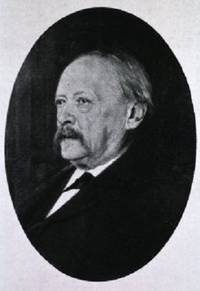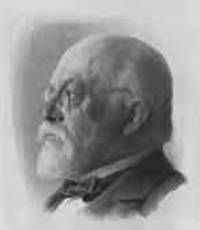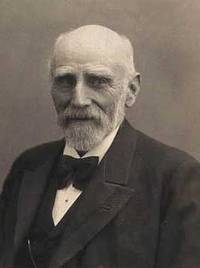Dr.Leo Burgerstein: An Austrian Specialist on School Health Issues Refers to Rasmus Malling-Hansen.
Transcription and Comments by Jørgen Malling Christensen:
Leo Burgerstein, 1853-1928, was a geologist and paleontologist, serving at the Geological Institute of the Vienna University from 1877 until 1882. However, later on in his career he was a secondary school teacher and developed a keen interest and deep expertise in school and popular health issues – in German ”Schulhygiene und Volksgesundheit”. In that capacity he published, together with August Netolitzky (1845-1924), ”Handbuch der Schulhygiene” in 1895. It became very popular and over the years ran in a total of 10 editions. Burgerstein was very appreciative of the contributions of the Swedish medical doctor Axel key (1832-1901), and in 1889 he published a thorough review of Key’s school health investigations[1].
Axel Key was a medical giant and towering figure, not only in his native Sweden but in medical research in the western world in general. He was one of the main contributors to the school planning commission of the Swedish Government which presented its report in 1885[2].
The following text is a transcription of relevant parts of Burgerstein’s publication; he starts with a quotation from Axel Key’s report 1885:
Page 245:
”Erst als ich dieses Kapitel für den Druck fertig korrigiert war, erhielt ich von den äusserst interessanten Untersuchungen von MALLING-HANSEN Kenntnis.[3] Wir befinden uns hier offenbar vor höchst wichtigen Fragen. Es wäre vor allem notwendig, die Kontrolle des Entwicklungsganges bei uns vorzunehmen.”[4]
Then LB continues with his own comments:
Es ist in hohen Grade Wünschenwert, dass parallele Untersuchungen in anderen Klimaten stattfinden; ich bemühe mich seit längerer Zeit vergeblich, die Leitung irgend eines Wiener Internater hierfür zu gewinnen.[5]
Da durch die ”Fragmente III.A. und III.B.” das ”Fragment I” natürlich überholt ist, die Arbeiten in deutscher Sprache erschienen und im Buchhandel zugänglich sind, muss ich selbstverständlich, dem Grundsatze, der in diesem Auszuge leitend war, folgend, von einer Wiedergabe dessen, was KEY aus ”Fragment I” anführt, hier absehen.
Page 246: (It is not clear whether the following part is a quotation from Key, or whether his is a comment by Burgerstein; I tend to think it is the latter).
In Dänemark werden die Wägungen wie MALLING-HANSEN mitteilt, fortgesetzt; die Geldmittel hiezu sind sowohl aus der Staatskasse als aus den „Carlsberg-Fonds“ bewilligt worden. Die Resultate werden aber nicht unmittelbar auf ein anderes Land mit anderem Klima etc anwendbar sein. Sie müssen also in jedem Lande, welches seiner aufwachsenden Jugend rationelle Fürsorge widmen will, speziell ausgeführt werden.
Leo Burgerstein also mentions two other important contemporary researchers in this field: The Danish medical doctor Axel Hertel[6] and the Swedish medical doctor Eric Wilhelm Wretlind[7]. Wretlind was, among many other tasks, attached to a number of Gothenburg schools as medical doctor, and in this capacity he weighed thousand of school children as early as from 1870 until 1878, i.e. before Malling-Hansen started his investigations. Wretlind reported his findings in the Medical Journal Eira no. 24 of Dec.28, 1878[8], which I have read. Unfortunately Wretlind limited his weight registrations to two days per year: Once in the beginning of September, just at the beginning of the school year, and once at the end of May, shortly before the long summer holiday. In addition, his article in Eira does not specify the technical details of how the children were weighed – with or without clothing, individually or in group. Wretlind has often been mentioned as one of the pioneers of using the weight of school children as an indication of their health. However, due to the limitations of his methods and the very limited frequency of his checks, the scientific value – at least of this study – is doubtful. Wretlind found no significant periodicity in tune with Malling-Hansen´s, but his study cannot be claimed to have the kind of scientific weight attached to Malling-Hansen´s or other serious researchers, such as Gustav Nylin and others later on.
Nevertheless, if other and more ambitious studies by Wretlind are discovered, this assessment may have to be re-valued.
Jørgen Malling Christensen
[1] JMC: “Axel Key’s Schulhygienische Untersuchungen, von Leo Burgerstein herausgegeben”, Hamburg und Leipzig 1889, Verlag von Leopold Voss.
[2] JMC: See further details about Axel Key and the Swedish report in our article: “RMH inspiring Swedish school system planning” under the chapter of “Periods in the growth of children”.
[3]LB: ”Über Periodicität im Gewicht der Kinder an täglichen Wägungen wahrgenommen“, durch Pastor R. MALLING-HANSEN, Vorsteher der königlichen Taubstummeninstituts in Kopenhagen. Fragment I. Kopenhagen 1883.
[4] LB: KEY gibt im Vorhergehenden, S. 565-570, einen Auszug am MALLING-HANSEN „Fragment I“. Siehe hierüber dis nach Ausgabe des Keyschen Werkes erschiene interessante und originale Arbeit von R. MALLING-HANSEN: „Perioden im Gewicht der Kinder und in der Sonnenwärme“. Fragment III.A. (268 S.) und 1 Taf., Fragment III B. Atlas in Gr. – Folio (44 Taf.), Kopenhagen, Tryde 1886.
[5] JMC: This is an important and interesting comment! First of all it indicates Burgersteins interest in this field of research and in the findings of RMH; secondly, it would be worthwhile to find out whether he actually succeded in carrying out a similar school research project which could verify RMHs findings! We need to dig deeper!
[6] JMC: Niels Theodor Axel Hertel, 1840-1911, medical doctor and school hygienist (i.e. expert in the health of school children). Hertel was a pioneer for school health issues in Denmark. In 1881 he published a book about the health situation of 4352 Copenhagen schoolchildren from 24 different schools – “Om Sundhedsforholdene i de højere Drenge- og Pigeskoler i København”, showing that 30-40 % of the children were suffering from various diseases or weaknesses. This led to a government commission 1882 and a proposed new law 1884, which, however, was not passed by parliament.
[7] JMC: Eric Wilhelm Wretlind, 1838-1905, Swedish medical doctor, writer, member of parliament and a teetotalism campaigner. Very active in religious circles. Editor of the medical journal ”Eira” from 1882 to 1897; published the layman medical journal ”Hälsovännen” from 1886 . He also published a large number of books on medical subjects, targeting a general audience.
[8] JMC: ”Iakttagelser rörande helsotillståndet i några av Göteborgs flickskolor”.




